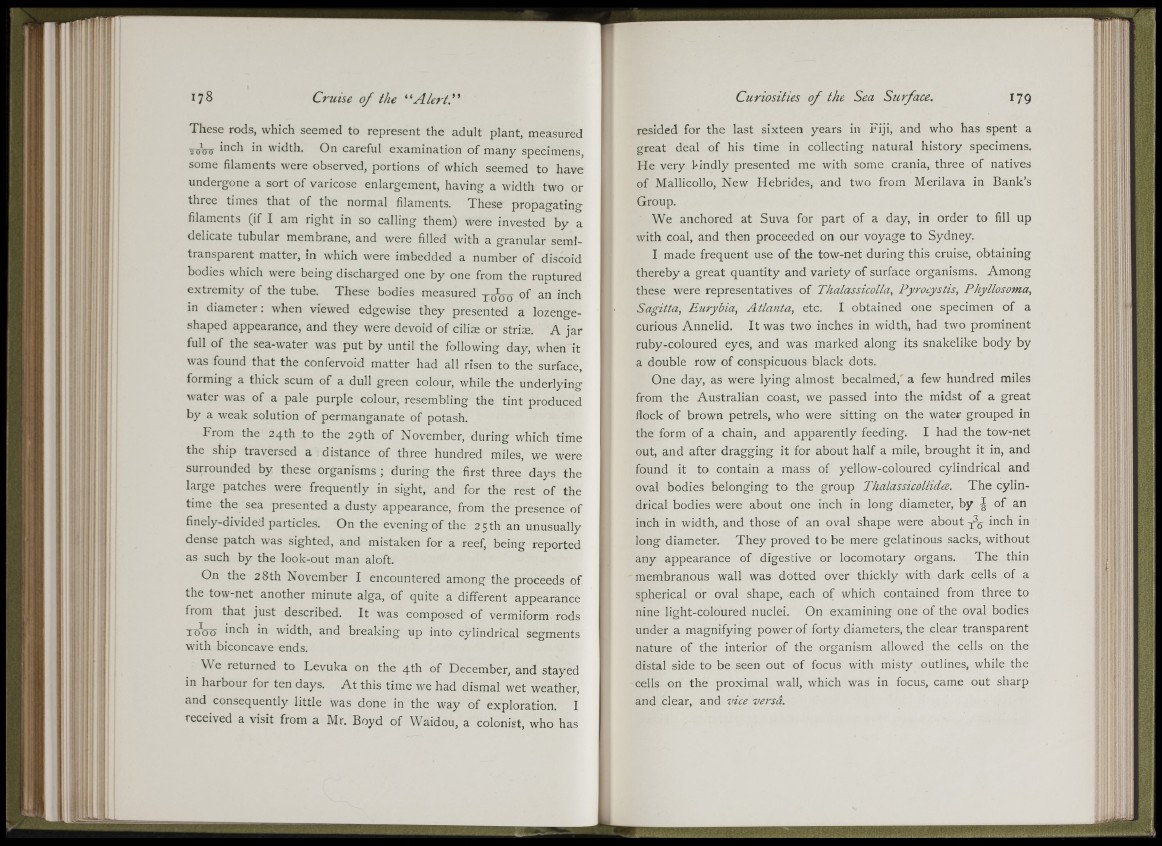
Ir .j
II ! ■ I
These rods, which seemed to represent the adult plant, measured
20W width. On careful examination of many specimens,
some filaments were observed, portions of which seemed to have
undergone a sort of varicose enlargement, having a width two or
three times that of the normal filaments. These propagating
filaments (if I am right in so calling them) were invested by a
delicate tubular membrane, and were filled with a granular semitransparent
matter, in which were imbedded a number of discoid
bodies which were being discharged one by one from the ruptured
extremity of the tube. These bodies measured of an inch
in diameter; when viewed edgewise they presented a lozengeshaped
appearance, and they were devoid of cilise or striae. A jar
full of the sea-water was put by until the following day, when it
was found that the confervoid matter had all risen to the surface,
forming a thick scum of a dull green colour, while the underlying
water was of a pale purple colour, resembling the tint produced
by a weak solution of permanganate of potash.
From the 24th to the 29th of November, during which time
the ship traversed a distance of three hundred miles, we were
surrounded by these organisms ; during the first three days the
large patches were frequently in sight, and for the rest of the
time the sea presented a dusty appearance, from the presence of
finely-divided particles. On the evening of the 25 th an unusually
dense patch was sighted, and mistaken for a reef, being reported
as such by the look-out man aloft.
On the 28th November I encountered among the proceeds of
the tow-net another minute alga, of quite a different appearance
from that just described. It was composed of vermiform rods
Toori Hch in width, and breaking up into cylindrical segments
with biconcave ends.
We returned to Fevuka on the 4th of December, and stayed
in harbour for ten days. A t this time we had dismal wet weather,
and consequently little was done in the way of exploration. I
received a visit from a Mr. Boyd of Waidou, a colonist, who has
resided for the last sixteen years in Fiji, and who has spent a
great deal of his time in collecting natural history specimens.
He very hindly presented me with some crania, three of natives
of Mallicollo, New Hebrides, and two from Merilava in Bank’s
Group.
We anchored at Suva for part of a day, in order to fill up
with coal, and then proceeded on our voyage to Sydney.
I made frequent use of the tow-net during this cruise, obtaining
thereby a great quantity and variety of surface organisms. Among
these were representatives of Thalassicolla, Pyrocystis, Phyllosoma,
Sagitta, Eurybia, Atlanta, etc. I obtained one specimen of a
curious Annelid. It was two inches in width, had two prominent
ruby-coloured eyes, and was marked along its snakelike body by
a double row of conspicuous black dots.
One day, as were lying almost becalmed, a few hundred miles
from the Australian coast, we passed into the midst of a great
fiock of brown petrels, who were sitting on the water grouped in
the form of a chain, and apparently feeding. I had the tow-net
out, and after dragging it for about half a mile, brought it in, and
found it to contain a mass of yellow-coloured cylindrical and
oval bodies belonging to the group Tkalassicollida. The cylindrical
bodies were about one inch in long diameter, by -3 of an
inch in width, and those of an oval shape were about inch in
long diameter. They proved to be mere gelatinous sacks, without
any appearance of digestive or locomotary organs. The thin
membranous wall was dotted over thickly with dark cells of a
spherical or oval shape, each of which contained from three to
nine light-coloured nuclei. On examining one of the oval bodies
under a magnifying power of forty diameters, the clear transparent
nature of the interior of the organism allowed the cells on the
distal side to be seen out of focus with misty outlines, while the
■cells on the proximal wall, which was in focus, came out sharp
and clear, and zdce versa.
*
m
!;1
3